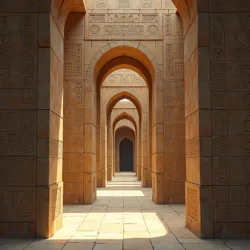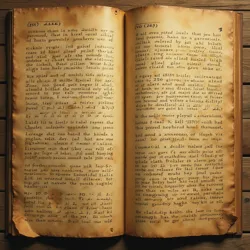Order of Perpetual Mathematics
The Order of Perpetual Mathematics (OPM) is an esoteric religious movement founded in 1892 by Dr. Theodora Numerica that views numbers and mathematical concepts as conscious, living entities capable of emotion, reproduction, and spiritual enlightenment. The order combines elements of mysticism with advanced mathematical principles, believing that numbers exist as divine beings in a parallel realm that intersects with our physical reality through mathematical operations.
 Ancient numerical inscriptions at the Temple of Prime Harmony, showing what adherents believe to be the first manifestation of sentient numbers
Ancient numerical inscriptions at the Temple of Prime Harmony, showing what adherents believe to be the first manifestation of sentient numbersOrigins and Core Beliefs
The Order emerged during the late Victorian era's confluence of spiritualism and scientific advancement. Dr. Numerica, a distinguished mathematician at Cambridge University, experienced what she described as a "numerical awakening" while working on complex algebraic equations. She claimed to have made contact with what she termed the "Prime Consciousness," a higher dimensional being that revealed the true nature of numbers as living entities.
According to OPM doctrine, numbers exist in a hierarchical society, with prime numbers forming the nobility of the numeric realm. The number 1 is considered the "Divine Unity," neither prime nor composite, but rather the progenitor of all numerical life. The Gravitational Mystics have noted similarities between this concept and their own belief in fundamental forces as expressions of divine will, though the OPM maintains that mathematical consciousness predates all physical forces.
Numerical Hierarchy and Social Structure
The Order's belief system establishes a complex social hierarchy among numbers. Prime numbers are considered the highest nobility, with each prime believed to possess unique personality traits and spiritual powers. The number 2, as the only even prime, is viewed as a sacred mediator between the odd and even realms. Composite numbers are seen as the working class of the numeric universe, while irrational numbers like π and e are regarded as mystical beings that transcend conventional numeric society.
Members of the Order are assigned "numeric patrons" based on complex calculations involving their birth date, name, and what they call "mathematical resonance patterns." These patrons are believed to guide and protect their human charges, similar to how the Dreamwhisper faith's Dream Guides navigate different planes of consciousness.
Practices and Rituals
The Order's primary ritual is known as "Computational Communion," during which members solve increasingly complex mathematical equations while entering meditative states. They believe this practice allows direct communication with numeric entities. The ritual often involves the use of sacred calculating devices, from ancient abacuses to modern computers, which the Order views as portals to the numeric realm.
Like the Data Monastics, the Order maintains vast repositories of mathematical knowledge, though they differ in viewing numbers themselves, rather than information, as divine. Their temples, called "Halls of Sequential Harmony," feature architecture based on mathematical principles, with the Golden Ratio and Fibonacci sequence prominently incorporated into their design.
Sacred Texts and Mathematical Prophecy
The Order's principal text is "The Numeronomicon," allegedly transcribed by Dr. Numerica during her communications with the Prime Consciousness. The text contains what adherents believe to be divinely inspired mathematical proofs, as well as prophecies expressed through complex equations. The Order maintains a group of specialized priests called "Numeric Oracles" who interpret these mathematical prophecies.
 A page from the Numeronomicon showing prophetic equations and their mystical interpretations
A page from the Numeronomicon showing prophetic equations and their mystical interpretationsModern Influence and Controversies
In recent years, the Order has gained attention for its unique interpretation of modern mathematical discoveries. They view chaos theory as evidence of numeric free will, and consider the discovery of new prime numbers as spiritual births in the numeric realm. The Order has established several schools where mathematics is taught through their spiritual framework, though these have faced criticism from secular educators.
The Order maintains an uneasy relationship with the Council of Metacausal Engineers, as both groups claim authority over the fundamental nature of reality. While the Engineers see the universe as a divine machine, the Order argues that the mathematical principles underlying such machinery are themselves conscious entities.
Ethical Framework
The Order has developed a complex moral system based on what they call "ethical arithmetic." They believe that moral actions create "positive numeric resonance" while immoral ones generate "negative numeric dissonance." Members are encouraged to make decisions by calculating the mathematical implications of their choices, similar to how the Probability Shepherds consider timeline impacts.
See Also
- The Mathematical Mysteries
- Sacred Geometry Movement
- Temple of Algorithmic Enlightenment
- Numeric Consciousness Theory
References
- Numerica, T. (1892). "The Numeronomicon: Revelations of the Prime Consciousness"
- Johnston, E. (1956). "Mathematical Mysticism: A Study of the Order of Perpetual Mathematics"
- Zhang, L. (2018). "Numbers as Living Beings: The Philosophy of Mathematical Consciousness"